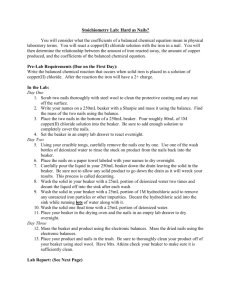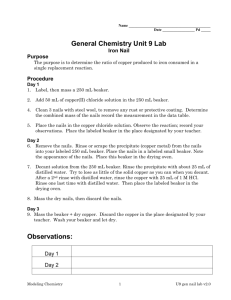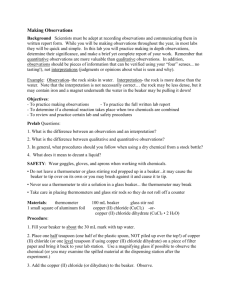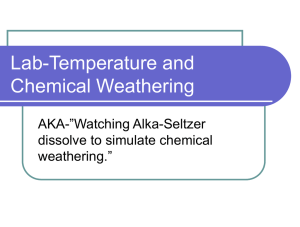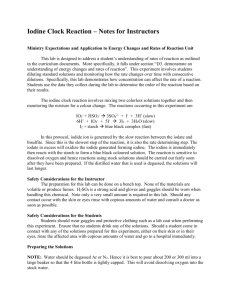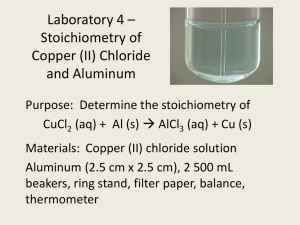Iron & Copper Chloride Reaction: Quantitative Analysis Lab Report
advertisement
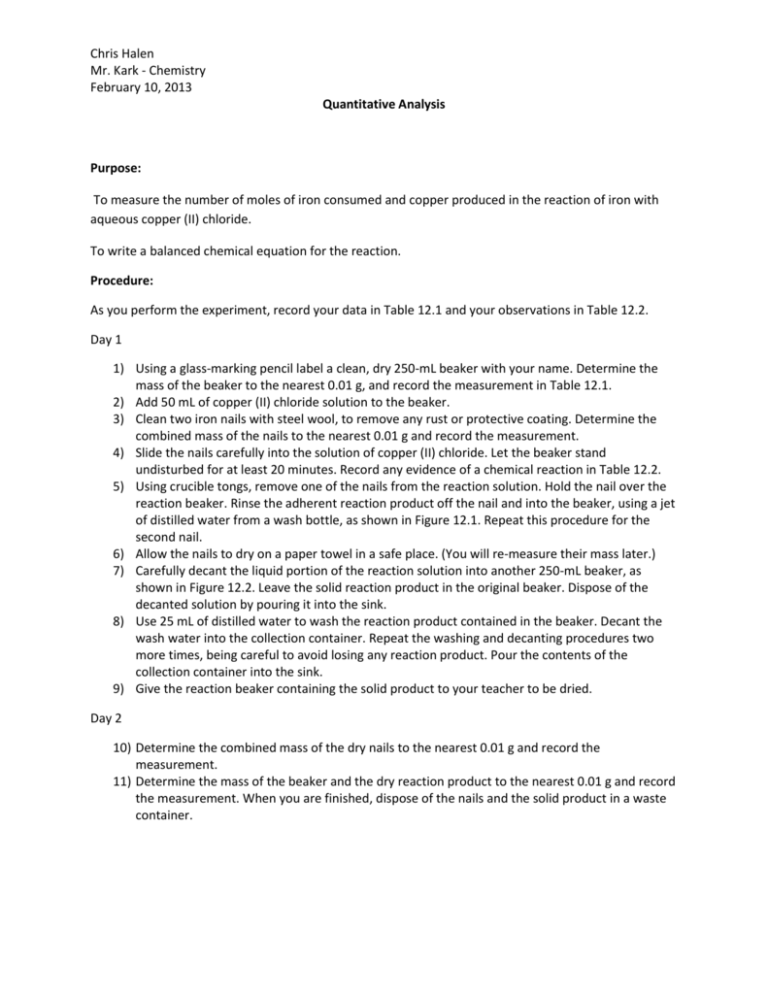
Chris Halen Mr. Kark - Chemistry February 10, 2013 Quantitative Analysis Purpose: To measure the number of moles of iron consumed and copper produced in the reaction of iron with aqueous copper (II) chloride. To write a balanced chemical equation for the reaction. Procedure: As you perform the experiment, record your data in Table 12.1 and your observations in Table 12.2. Day 1 1) Using a glass-marking pencil label a clean, dry 250-mL beaker with your name. Determine the mass of the beaker to the nearest 0.01 g, and record the measurement in Table 12.1. 2) Add 50 mL of copper (II) chloride solution to the beaker. 3) Clean two iron nails with steel wool, to remove any rust or protective coating. Determine the combined mass of the nails to the nearest 0.01 g and record the measurement. 4) Slide the nails carefully into the solution of copper (II) chloride. Let the beaker stand undisturbed for at least 20 minutes. Record any evidence of a chemical reaction in Table 12.2. 5) Using crucible tongs, remove one of the nails from the reaction solution. Hold the nail over the reaction beaker. Rinse the adherent reaction product off the nail and into the beaker, using a jet of distilled water from a wash bottle, as shown in Figure 12.1. Repeat this procedure for the second nail. 6) Allow the nails to dry on a paper towel in a safe place. (You will re-measure their mass later.) 7) Carefully decant the liquid portion of the reaction solution into another 250-mL beaker, as shown in Figure 12.2. Leave the solid reaction product in the original beaker. Dispose of the decanted solution by pouring it into the sink. 8) Use 25 mL of distilled water to wash the reaction product contained in the beaker. Decant the wash water into the collection container. Repeat the washing and decanting procedures two more times, being careful to avoid losing any reaction product. Pour the contents of the collection container into the sink. 9) Give the reaction beaker containing the solid product to your teacher to be dried. Day 2 10) Determine the combined mass of the dry nails to the nearest 0.01 g and record the measurement. 11) Determine the mass of the beaker and the dry reaction product to the nearest 0.01 g and record the measurement. When you are finished, dispose of the nails and the solid product in a waste container. Halen 2 Data Table: Table 12.1 Mass Determinations Items Mass (g) Empty Dry Beaker 82.65 Iron Nails (before reaction) 22.072 Iron Nails (after reaction) 20.659 Beaker and Dry Product 84.06 Calculations: 1) Mass of Fe Reacted 22.072g – 20.659 = 1.413g 2) Moles of Fe Reacted 1.413g (1 mol / 55.847g) = .02530 mol 3) Mass of Cu Formed 84.06g – 82.65g = 1.41 g 4) Moles of Cu Formed 1.41g (1mol / 63.55g) = .0222 mol 5) Fe(s) + CuCl2(aq) FeCl2 (aq) + Cu(s) Calculation mol Fe: mol Cu .02530 : .0222 1.14 : 1.00 Halen 3 6) % Error = ((Accepted – Experimental) / 1.000mol) x 100 (1.14 – 1.00) / 1.00 .14 x 100 = 14% 7) Calculating Mass of Cu That Should Have Formed 1.413g Fe (1mol / 55.847g) (1mol Cu/ 1 mol Fe) (63.546g Cu / 1 mol Cu) = 1.608g 8) %Error = ((Accepted – Experimental) / 1.000mol) x 100 (1.608 – 1.41) / 1.608 (.20 / 1.608) x 100 = 12% 9) % Yield = (Actual / Theoretical) x 100 (1.41 / 1.608) x 100 = 87.7 % Table of Calculations: Description Results Fe Reacted (g) 1.413 Fe Reacted (mol) .02530 Cu Formed (g) 1.41 Cu Formed (mol .0222 Mol Fe : Mol Cu 1.41 : 1.00 Error Using Mols (%) 14 Theoretical Amount of Cu Produced (g) 1.608 Error Using Mass (%) 12 Yield (%) 87.7 Halen 4 Discussion of Results: In the single replacement reaction of Fe and Copper (II) chloride, Fe replaces Cu2+ ions to produce Iron (II) chloride and a copper precipitate. Theoretically, 1.608g of Cu should have formed in the reaction. 1.41g of Cu was formed which was lower than expected and caused a 12% error. There were multiple possible places in the procedure where errors could have been committed. One possibility was pouring Cu out of the beaker when cleaning it of other chemicals. To fix this, the Cu must be allowed to settle after squirting it with water before pouring it out. Another contributing factor to this was scraping the Cu off the nail into the beaker. If Cu missed the beaker, it altered the results. When the Cu was heated to dry, a possible place for error was having the Cu pop out of the beaker. If the Cu was heated too quickly and vigorously, the Cu would pop out and alter the results. The last main possible place for error was leaving some Cu on the nail. If any Cu was left on the nail, it would alter the by causing less Fe reacting and ultimately causing the results to be lower. This also caused the theoretical amount to be higher. This could be fixed by being more thorough when removing the Cu from the nail. Conclusion: The purpose of the lab was to measure how many moles of iron would be consumed and copper produced with the reaction of iron and aqueous copper (II) chloride. The procedure first involved measuring the an empty beaker and nails before the reaction. The nails were put in a beaker with copper (II) chloride. Copper was formed on the nails. The liquid in the beaker was poured out and the copper on the nails scraped in the beaker. Again the nails and beaker were weighed. Theoretically, 1.608g of Cu should have formed in the reaction. 1.41g of Cu was formed which was lower than expected and caused a 12% error. A major source of error was accidentally pouring copper out of the beaker when getting rid of the copper (II) chloride. The results were inconclusive with a 12% error and further experimentation is needed.
